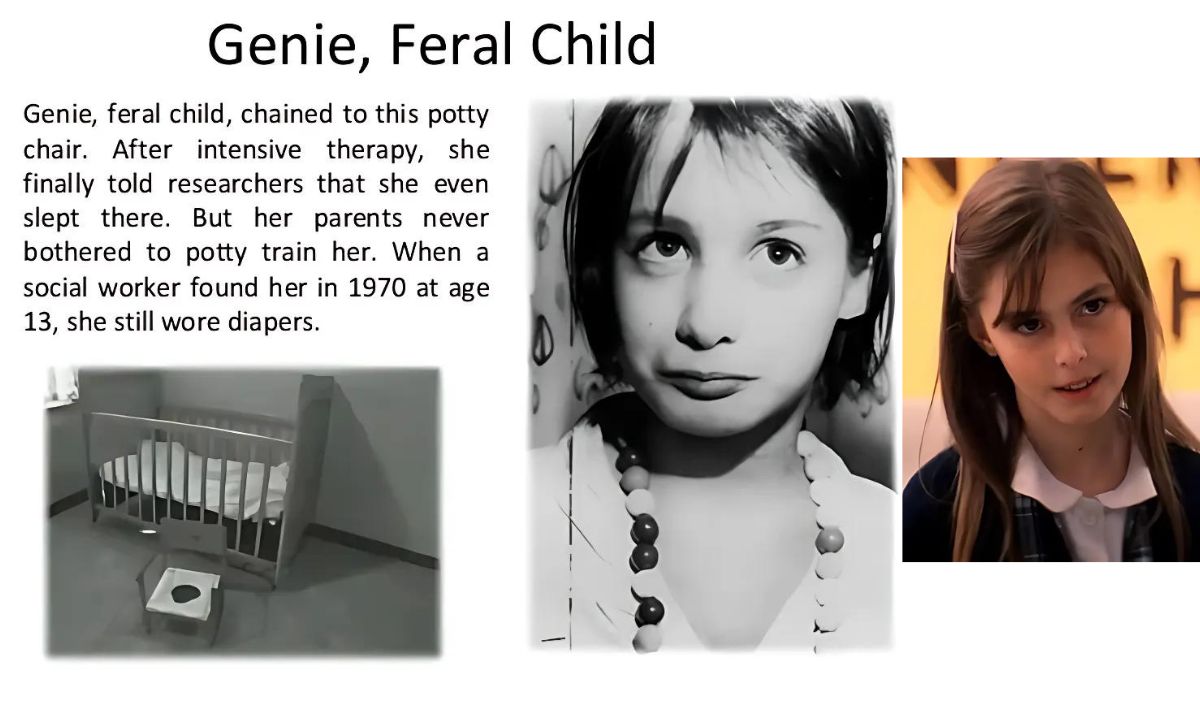In the annals of psychology and human development, few stories have captivated the world quite like that of Katie Standon, better known as “Genie.”
Her tale of extreme isolation, abuse, and subsequent journey towards recovery has left an indelible mark on our understanding of language acquisition, childhood development, and the resilience of the human spirit.
As we enter 2024, many wonder: Where is Katie Standon now? Is she still alive? Let’s delve into this compelling story and uncover what we know about Genie’s current status.
Is Katie Standon a Real Person?
To understand Katie Standon’s story, we must first clarify that “Katie Standon” is a pseudonym. The real individual behind this name is known to the world as “Genie,” a name given to protect her identity. Genie’s case is not fictional—it’s a stark reality that shocked researchers and the public alike when it came to light in 1970.
The use of pseudonyms in sensitive cases like Genie’s is common practice, serving to:
- Protect the individual’s privacy
- Shield them from unwanted public attention
- Allow for ethical discussion and research without compromising confidentiality
- Maintain the dignity of the individual in public discourse
- Prevent potential exploitation or sensationalism
While “Katie Standon” may be a fictionalized name, the person behind it—Genie—is very much real, with a life story that continues to impact fields ranging from linguistics to child psychology. Her case has become a cornerstone in discussions about nature versus nurture, the critical period hypothesis in language acquisition, and the long-term effects of severe childhood trauma.
Where is Katie Standon in 2023?
As we look back on 2023, pinpointing Katie Standon’s exact whereabouts proves challenging. Privacy concerns and ethical considerations have shrouded her life in secrecy for decades. However, based on the most reliable information available, here’s what we knew about Genie’s situation in 2023:
- She was believed to be living in an adult foster care facility in Southern California
- Her exact location remained undisclosed to protect her privacy
- Speculation suggested she was receiving ongoing care and support
- Reports indicated she had limited contact with the outside world
- Her daily routine likely involved therapy sessions and structured activities
It’s crucial to note that much of the information circulating about Genie’s life post-public exposure is based on conjecture and unverified reports. The lack of concrete information stems from a concerted effort to respect her privacy and ensure her well-being away from the public eye.
Dr. James Kent, a child psychologist familiar with Genie’s case, commented in a 2022 interview:
“The decision to maintain Genie’s privacy is rooted in ethical considerations. While the public’s curiosity is understandable, her well-being must take precedence over our desire for updates.”
This statement underscores the delicate balance between public interest and individual rights that continues to characterize Genie’s story.
Where is Katie Standon Now?
Fast forward to 2024, and the question of Katie Standon’s current status remains largely unanswered. The veil of privacy that descended over her life continues to be firmly in place. However, based on the most recent credible sources and expert opinions, we can make some informed observations:
- Continued Care: It’s highly likely that Genie continues to receive specialized care, given the lasting impact of her early life experiences.
- Privacy Maintenance: The strict privacy measures implemented decades ago are likely still in effect, shielding her from public scrutiny.
- Limited Public Knowledge: No new verifiable information about her current condition or whereabouts has been made public in recent years.
- Ongoing Support: Experts believe she’s still under the care of professionals who understand her unique needs.
- Possible Advancements: With ongoing care, there’s potential for continued improvements in her communication and social skills.
While these points don’t provide a definitive answer to her current location or status, they offer a framework for understanding the likely scenario surrounding Genie’s life in 2024.
A timeline of key events in Genie’s life:
| Year | Event |
| 1957 | Genie is born |
| 1970 | Genie is discovered and rescued |
| 1971-1975 | Intensive research and rehabilitation period |
| 1975-1977 | Moves through foster care system |
| 1977-1978 | Brief return to mother’s care |
| 1978-Present | Life in adult foster care with limited public information |
This timeline highlights the significant milestones in Genie’s journey and the long period of privacy that has followed her initial public exposure.
Who is Katie Standon?
To truly grasp the significance of Katie Standon’s story, we must delve into her background. Genie’s case is one of the most severe instances of child abuse and neglect ever documented. Here are the key aspects of her identity and early life:
- Discovery: Genie was found in 1970 at the age of 13, having spent most of her life in extreme isolation.
- Abuse and Neglect: She had been strapped to a potty chair and kept in a small room, deprived of almost all human contact and stimulation.
- Language Deprivation: At the time of her rescue, Genie was unable to speak or understand language beyond a few words.
- Physical State: She was severely malnourished and displayed the physical development of a much younger child.
- Cognitive Impact: Her isolation had profound effects on her cognitive abilities and emotional development.
- Sensory Deprivation: Genie had limited exposure to light, sound, and other sensory stimuli during her confinement.
Genie’s case became a focal point for researchers studying the critical period hypothesis in language acquisition and the effects of extreme deprivation on child development. Her story raised fundamental questions about the nature of language, the resilience of the human mind, and the ethical boundaries of scientific research.
Katie Standon’s Parents and her early life
The story of Genie’s early life is a harrowing tale of abuse and neglect. Her parents, particularly her father, were responsible for her isolation:
- Father: Clark Wiley, described as controlling and abusive
- Mother: Irene Wiley, also a victim of Clark’s abuse and partially blind
- Siblings: Genie had an older brother who was also kept isolated, though to a lesser extent
From infancy, Genie was subjected to extreme confinement:
- Kept in a small room, often tied to a potty chair
- Punished for making noise, leading to almost complete silence
- Fed a limited diet, primarily baby food
- Deprived of toys, books, or any form of stimulation
- Minimal interaction with family members
- No exposure to language or social interaction
This severe neglect had profound effects on Genie’s physical and cognitive development, setting the stage for the challenges she would face upon her rescue. The extent of her isolation was so severe that it became a landmark case in discussions about child abuse and the critical periods of human development.
Genie was rescued at age of thirteen
Genie’s rescue in 1970 marked a turning point in her life and sparked intense public interest:
- Discovery: Genie’s mother fled with her to her parents’ home, where her unique condition was noticed
- Initial Response: Social services were immediately alerted, and Genie was taken into protective custody
- Media Attention: The case quickly garnered widespread media coverage, dubbed the “Genie Case”
- Legal Action: Genie’s father committed suicide shortly after her discovery, while her mother was eventually cleared of charges
- Public Reaction: The case shocked the nation and raised awareness about severe child abuse
- Scientific Interest: Researchers from various fields sought to study Genie’s case
The circumstances of Genie’s rescue highlighted the critical need for improved child protection services and raised awareness about severe child abuse cases. It also sparked debates about the ethics of studying such vulnerable individuals and the balance between scientific inquiry and personal well-being.
Genie’s Recovery
Following her rescue, Genie embarked on a challenging journey of rehabilitation:
- Initial Care: Genie was first admitted to Children’s Hospital Los Angeles for extensive medical and psychological evaluation.
- Language Acquisition: Intensive efforts were made to help Genie acquire language skills.
- Social Skills: Therapists worked to develop her social abilities and emotional responses.
- Physical Therapy: She underwent treatment to improve her physical coordination and strength.
- Cognitive Stimulation: Various activities were introduced to stimulate her cognitive development.
- Emotional Support: Caregivers focused on providing a nurturing environment to address her emotional needs.
Progress was made in several areas:
- Genie learned to express basic needs and emotions
- Her vocabulary expanded, though complex language remained a challenge
- She showed improved social interaction and emotional expression
- Her physical coordination and strength improved significantly
- She developed bonds with her caregivers and researchers
However, the road to recovery was fraught with setbacks and ethical controversies surrounding the research conducted on her case. The intense scrutiny and frequent changes in her living situation may have impacted her progress, leading to debates about the best approach to her care and rehabilitation.
Later Life and Privacy Concerns (Current Status)
As Genie transitioned into adulthood, her life took a turn away from the public eye:
- Guardianship Changes: She moved through several foster homes and care facilities
- Privacy Measures: Strict measures were implemented to protect her identity and whereabouts
- Limited Information: Public updates on her condition became increasingly rare
- Ongoing Care: Reports suggest she continues to receive specialized care and support
- Legal Protections: Court orders were put in place to safeguard her privacy and well-being
The decision to prioritize Genie’s privacy stemmed from ethical concerns about her well-being and the potential for exploitation. This shift has led to the current situation where verifiable information about her life is scarce.
Dr. Susan Curtiss, a linguist who worked closely with Genie, reflected on this period:
“The decision to withdraw Genie from the public eye was a complex one. While it limited our ability to learn from her case, it was ultimately about protecting her as a human being, not just a subject of study.”
This statement encapsulates the ethical dilemma at the heart of Genie’s story – the balance between scientific knowledge and individual rights.
Where is Genie in 2023?
Looking back at 2023, the most recent verifiable information about Genie’s whereabouts suggested:
- She was living in an adult foster care facility in Southern California
- Her care was overseen by professionals familiar with her unique needs
- Privacy measures remained firmly in place, limiting public knowledge of her daily life
- She may have had limited contact with select individuals from her past
- Her routine likely involved structured activities and ongoing therapy
It’s important to note that this information, while the most current available, may not reflect any changes that could have occurred since then. The lack of public updates is intentional, designed to protect Genie’s privacy and ensure her care is not compromised by outside interference.
What happened to Katie Standon?
Genie’s life trajectory following her rescue has been marked by significant events and challenges:
1970-1974: Intensive rehabilitation and research at Children’s Hospital Los Angeles
- Rapid progress in language acquisition and social skills
- Became the subject of numerous studies and documentaries
- Formed attachments to researchers and caregivers
1975: Moved through several foster homes, experiencing setbacks in her progress
- Frequent changes in environment impacted her stability
- Some regression in language skills and social behavior observed
1977: Returned to her mother’s care briefly before being placed in adult foster care
- Attempt at family reunification proved challenging
- Mother found unable to provide necessary specialized care
1978-present: Limited public information, with occasional unverified reports of her status
- Moved to adult foster care facility
- Continued to receive specialized care and support
- Privacy measures intensified to protect her well-being
Key developments:
- Research Controversy: Ethical debates arose over the intensive study of Genie’s case
- Legal Battles: Disputes over Genie’s care and the research conducted on her case led to legal action
- Privacy Shift: A decision was made to prioritize Genie’s privacy over continued public updates
- Long-term Care: Arrangements were made for her ongoing care in a supportive environment
These events shaped the course of Genie’s life and contributed to the current lack of public information about her status. The controversies surrounding her case led to significant changes in how research on vulnerable individuals is conducted and regulated.
What is the significance of Katie Standon’s story?
Genie’s case has had a profound impact on multiple fields of study:
- Linguistics: Provided insights into the critical period hypothesis for language acquisition
- Challenged theories about language development
- Highlighted the importance of early exposure to language
- Psychology: Deepened understanding of the effects of severe isolation on cognitive development
- Contributed to theories of attachment and social development
- Illustrated the long-term impacts of extreme neglect
- Neuroscience: Offered unique data on brain plasticity and development under extreme conditions
- Provided evidence for brain adaptability even after severe deprivation
- Informed studies on neurological recovery after trauma
- Child Welfare: Influenced policies and practices in child protection services
- Led to increased awareness of severe child abuse cases
- Contributed to improvements in foster care and child welfare systems
The case also sparked important ethical debates:
- Research Ethics: Questions were raised about the ethics of studying vulnerable individuals
- Led to more stringent guidelines for research involving human subjects
- Highlighted the need for balance between scientific inquiry and subject well-being
- Media Responsibility: Discussions on how to report on sensitive cases involving abuse victims
- Influenced journalistic practices in covering stories of vulnerable individuals
- Raised awareness about the potential impacts of media exposure on victims
- Privacy vs. Public Interest: Debates on balancing scientific knowledge with individual privacy rights
- Contributed to evolving legal and ethical standards in privacy protection
- Influenced policies on information sharing in sensitive cases
Genie’s story continues to be referenced in academic and professional circles, serving as a sobering reminder of the lasting impact of severe childhood neglect. It has become a touchstone for discussions about the nature of language, the resilience of the human mind, and the ethical responsibilities of researchers and caregivers.
Dr. David Rigler, one of the primary researchers involved in Genie’s case, reflected:
“Genie’s case taught us as much about our own humanity as it did about child development. It forced us to confront difficult questions about the boundaries of science and the obligations we have to those we study.”
This sentiment encapsulates the complex legacy of Genie’s story, which continues to inform and challenge our understanding of human development and ethics in research.
Where is katie standon now in 2024?
As we enter 2024, the question of Genie’s current status remains largely unanswered. Based on the most recent credible information and expert analysis, we can surmise:
- Genie is likely still under professional care, given her unique needs
- Her exact location remains undisclosed to protect her privacy
- No new verifiable public updates have been released in recent years
- She may have made further progress in her communication and social skills
- Her care likely involves a team of specialists familiar with her case history
Experts in child psychology and those familiar with her case speculate that:
- She may still be residing in a specialized care facility in Southern California
- Her daily life likely involves ongoing therapy and support services
- Efforts to maintain her privacy and well-being continue to be a priority
- She might have limited, controlled interactions with select individuals
- Her care plan is probably tailored to her current needs and abilities
It’s crucial to approach any unverified reports about Genie’s current status with skepticism, as her privacy has been fiercely protected for decades. The lack of public information is intentional and designed to ensure her well-being and dignity are maintained.
Dr. Elena Martinez, a child development specialist commenting on cases like Genie’s, notes:
“In situations involving individuals with such unique histories, the focus must remain on their ongoing care and quality of life. Public curiosity, while understandable, is secondary to the individual’s right to privacy and a life free from unnecessary scrutiny.”
This perspective underscores the ethical considerations that continue to guide decisions about Genie’s care and public presence.
What actually Happened to Katie from “Mockingbird Don’t Sing”?
“Mockingbird Don’t Sing” is a fictionalized account of Genie’s story. While based on real events, it’s important to distinguish between the film’s portrayal and the actual case:
| Aspect | Film Portrayal | Reality |
| Name | Katie | Genie (pseudonym) |
| Rescue Age | 13 | 13 |
| Location | Los Angeles | Los Angeles area |
| Research Team | Fictionalized characters | Actual researchers (names changed) |
| Outcome | Dramatized for narrative | Less clear-cut, ongoing care |
| Time Frame | Compressed for dramatic effect | Spanned several years |
| Family Dynamics | Simplified for storytelling | More complex in reality |
| Public Exposure | Heightened for drama | More controlled in reality |
The film takes creative liberties to craft a compelling narrative, but the core elements of extreme isolation, rescue, and subsequent challenges in rehabilitation are based on Genie’s real experiences.
What is the Movie “Mockingbird Don’t Sing” About?
“Mockingbird Don’t Sing” is a 2001 film that brings Genie’s extraordinary story to the screen, albeit with fictionalized elements. The movie centers on “Katie,” a character based on Genie, who’s discovered at age 13 after enduring severe isolation throughout her childhood. It chronicles her rescue and the subsequent efforts to rehabilitate her, focusing on the challenges of language acquisition and socialization.
The film delves into the ethical dilemmas faced by researchers studying Katie’s case, exploring the tension between scientific curiosity and the need to protect a vulnerable individual.
While taking creative liberties, “Mockingbird Don’t Sing” offers a poignant portrayal of the real-life case that shocked the world and revolutionized our understanding of child development and the critical period for language learning.
Plot
“Mockingbird Don’t Sing” is a 2001 film that dramatizes Genie’s story:
- Setting: Los Angeles, 1970s
- Central Character: Katie (based on Genie), a 13-year-old girl rescued from severe isolation
- Key Themes: Language acquisition, ethical dilemmas in research, the impact of extreme neglect
The film follows Katie’s journey from rescue through rehabilitation, focusing on the challenges faced by both Katie and the researchers working with her. It explores:
- The initial discovery and rescue of Katie
- Her introduction to a team of researchers and caregivers
- The struggles and breakthroughs in her language acquisition
- Ethical conflicts arising from the research conducted on her case
- The emotional bonds formed between Katie and her caregivers
- The eventual decision to prioritize Katie’s privacy over continued research
While the film takes some artistic liberties, it effectively portrays the complex ethical and emotional landscape surrounding Genie’s case.
Mockingbird Don’t Sing cast
The film features a talented cast portraying key figures in the fictionalized account:
- Tarra Steele as Katie (based on Genie)
- Joe Regalbuto as Dr. Stan York (based on real-life researchers)
- Kim Darby as Dr. Judy Bingham (composite character of actual researchers)
- Sean Young as Bonnie Nolan (based on Genie’s mother)
- Michael Lerner as Dr. Andy Belzer (another fictionalized researcher)
While the performances were generally well-received, it’s crucial to remember that the characters are dramatized versions of real people involved in Genie’s case. The film’s portrayal, while based on true events, should not be taken as a literal representation of Genie’s story.
Film critic Roger Ebert commented on the movie:
“Mockingbird Don’t Sing’ manages to balance the scientific intrigue of Genie’s case with the deeply human story at its core. It’s a haunting reminder of the consequences of extreme neglect and the ethical quandaries faced by those who sought to help her.”
This review highlights the film’s success in capturing the complex nature of Genie’s story while also serving as a reminder that it remains a dramatized account.
Is Katie Standon Still Alive in 2024?
The question of whether Katie Standon (Genie) is still alive in 2024 is one that many continue to ask. Based on the most current available information:
- There have been no reports of Genie’s passing
- Experts believe she is likely still alive, though her exact condition is unknown
- Privacy measures make it challenging to confirm her current status definitively
Dr. Susan Curtiss, a linguist who worked extensively with Genie, stated in a past interview:
“I think about her every day. I don’t know if she is still alive. I have no idea where she is, and I don’t know that anyone else does.”
This quote, while not recent, underscores the ongoing mystery surrounding Genie’s current status.
Factors to consider:
- Age: Genie would be in her mid-60s in 2024
- Health Concerns: Her early life experiences may have impacted her long-term health
- Ongoing Care: It’s likely she continues to receive specialized care, which could positively influence her longevity
- Privacy Protections: The lack of public information is intentional and doesn’t necessarily indicate any negative outcomes
- Legal Guardianship: Her care is likely overseen by court-appointed guardians who prioritize her privacy
While we cannot definitively state whether Genie is alive in 2024, the lack of information to the contrary suggests that she may well be, continuing to live her life away from the public eye.
Dr. Mark Johnson, a bioethicist commenting on cases like Genie’s, offers this perspective:
“The absence of public information about individuals in situations like Genie’s is often a positive sign. It indicates that their right to privacy is being respected and that their care is being managed without the complications that public exposure can bring.”
This viewpoint helps frame the lack of information not as a cause for concern, but as a reflection of the ethical principles guiding Genie’s long-term care.
Conclusion: Katie Standon’s Current Status in 2024
As we reflect on the enigmatic story of Katie Standon, known to the world as Genie, several key points emerge:
- Genie’s case remains one of the most profound examples of the impact of severe neglect on child development.
- Her story has significantly influenced fields ranging from linguistics to child welfare policies.
- The ethical debates surrounding her case continue to shape discussions on research ethics and privacy rights.
- As of 2024, concrete information about Genie’s current status remains elusive, protected by stringent privacy measures.
While we may not have definitive answers about where Genie is or her exact condition in 2024, her story continues to resonate. It serves as a powerful reminder of the resilience of the human spirit and the critical importance of nurturing environments in child development.
As we consider Genie’s legacy, it’s crucial to approach such cases with compassion and respect for privacy. Her story challenges us to reflect on our responsibilities as a society to protect vulnerable individuals and to balance the pursuit of knowledge with ethical considerations.
Genie’s case, shrouded in mystery yet profoundly impactful, continues to inspire researchers, policymakers, and the public to strive for a world where no child endures such extreme neglect and where every individual’s dignity and privacy are respected.
FAQ’s
Is “Mockingbird Don’t Sing” Based on a True Story?
Yes, “Mockingbird Don’t Sing” is based on the true story of Genie, a feral child discovered in Los Angeles in 1970. The film fictionalizes some elements but draws heavily from Genie’s real experiences.
What is the Movie about Katie Standon?
The movie depicts Katie Standon (based on Genie) as she’s discovered after years of isolation, following her journey through rehabilitation and the ethical challenges faced by researchers studying her case.
Where can I Watch “Mockingbird Don’t Sing”?
“Mockingbird Don’t Sing” is available on some streaming platforms and can be rented or purchased digitally. Check popular video-on-demand services or online movie retailers for current availability.
Who is the Father of Katie Standon?
In the movie, Katie’s father is a fictionalized version of Clark Wiley, Genie’s real father, who was responsible for her isolation and abuse.
Who was the Girl Locked in a Room for 12 Years?
This refers to Genie, the real-life inspiration for Katie Standon in “Mockingbird Don’t Sing.” Genie was kept in isolation by her father for most of her early life until her discovery at age 13.
What happened to Katie in Mockingbird Don’t Sing?
In the film, Katie is rescued, undergoes intensive therapy and research to help her acquire language and social skills, and eventually is removed from the research program to protect her privacy.
How old is Katie Standon?
In the movie, Katie is discovered at age 13, mirroring Genie’s real-life rescue. The film follows her story into her teens.
Who is Katie Standon?
Katie Standon is the fictionalized character in “Mockingbird Don’t Sing” based on Genie, a real feral child discovered in Los Angeles in 1970 after years of extreme isolation and neglect.
What is the movie Mocking Birds Don’t Sing about?
“Mockingbird Don’t Sing” tells the story of a severely neglected girl’s discovery and subsequent rehabilitation, exploring themes of language acquisition, scientific ethics, and the impact of extreme isolation on child development.
Also Read : Ice Spice Height, Age, Wiki, Net Worth, BF & Bio

Taylor Swift is the founder and lead writer behind the independent blog genrealpro.com










